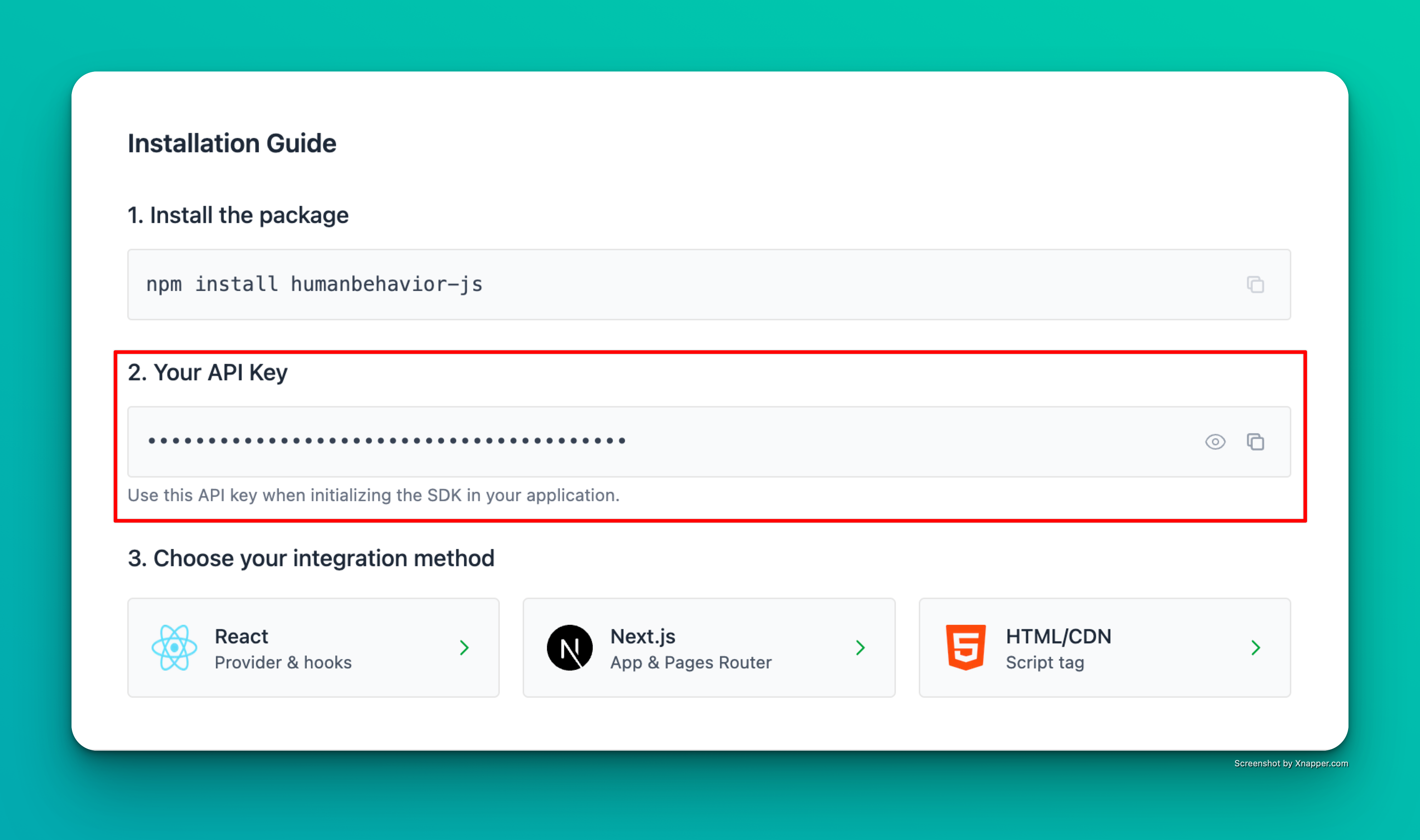Using HumanBehaviorTracker with Nuxt.js
Quickstart
Human Behavior works seamlessly to record sessions on your Nuxt.js app.
Show How to get your API Key
How to find your Public API Key:
Flow: Project Home → Integrations → Human Behavior SDK → Kebab Menu → Configuration → Public API Key

Example screenshot – your actual API key will be different.
Step 1: Installation
npm install humanbehavior-js
# or
yarn add humanbehavior-js
Step 2: Environment Variables
Create an environment file (.env) with your API key:
NUXT_PUBLIC_HUMANBEHAVIOR_API_KEY=your-api-key-here
Step 3: Basic Setup
Update nuxt.config.ts
Update nuxt.config.ts with environment variable in runtimeConfig:
export default defineNuxtConfig({
runtimeConfig: {
public: {
humanBehaviorApiKey: process.env.NUXT_PUBLIC_HUMANBEHAVIOR_API_KEY
}
}
})
Step 4: Basic Setup
Add the Tracker to Your App
Create a plugin in plugins/humanbehavior.client.ts:
import { HumanBehaviorTracker } from 'humanbehavior-js';
export default defineNuxtPlugin(() => {
const config = useRuntimeConfig();
const apiKey = config.public.humanBehaviorApiKey;
const tracker = apiKey ? HumanBehaviorTracker.init(apiKey as string) : null;
return {
provide: {
tracker: tracker as HumanBehaviorTracker | null
}
};
});
That’s it! The SDK now automatically tracks user interactions, navigation, and console events. Everything past here is optional.
Optional: Advanced Features
Track Custom Events
<template>
<div>
<h1>My Component</h1>
<button @click="handleButtonClick">Click Me</button>
</div>
</template>
<script setup>
import { onMounted } from 'vue';
const { $tracker } = useNuxtApp();
onMounted(() => {
// Track component view
$tracker.customEvent('component_viewed', {
componentName: 'MyComponent'
});
});
async function handleButtonClick() {
await $tracker.customEvent('button_clicked', {
buttonLocation: 'header'
});
}
</script>
User Authentication Example
<template>
<div>
<form @submit.prevent="handleLogin">
<input v-model="email" type="email" placeholder="Email" />
<input v-model="password" type="password" placeholder="Password" />
<button type="submit">Login</button>
</form>
</div>
</template>
<script setup>
import { ref } from 'vue';
const email = ref('');
const password = ref('');
const { $tracker } = useNuxtApp();
async function handleLogin() {
try {
// Your login logic here
const user = await login(email.value, password.value);
if (user) {
// Identify user with current endUserId
await $tracker.identifyUser({
userProperties: {
email: user.email,
name: user.name,
userId: user.id,
plan: user.plan
}
});
}
} catch (error) {
console.error('Login failed:', error);
}
}
</script>
Environment Variables
# .env
NUXT_PUBLIC_HUMANBEHAVIOR_API_KEY=your-api-key-here
nuxt.config.ts:
export default defineNuxtConfig({
runtimeConfig: {
public: {
humanBehaviorApiKey: process.env.NUXT_PUBLIC_HUMANBEHAVIOR_API_KEY
}
}
});
// In your plugin
const apiKey = config.public.humanBehaviorApiKey;
Troubleshooting
- Check browser console for any error messages
- Verify your API key is correct
- Ensure the tracker is initialized before any user interaction


